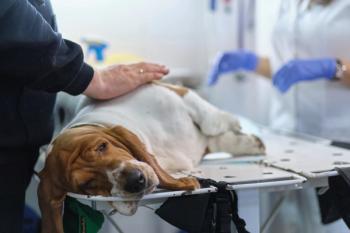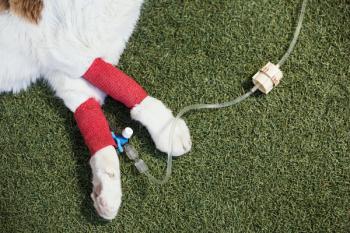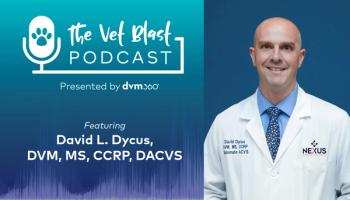
Getting dogs back on their paws
A Q&A with canine physical rehabilitation expert Darryl Millis, DVM.
Editor's Note: Darryl Millis, DVM, is a professor of orthopedic surgery and the director of surgical services in the Department of Small Animal Clinical Sciences at the University of Tennessee in Knoxville. He is a Diplomate of the American College of Veterinary Surgeons, a Diplomate of the American College of Sports Medicine and Rehabilitation and a Certified Canine Rehabilitation Practitioner. Millis is the co-editor of the textbooks Essential Facts of Physiotherapy in Dogs and Cats; Multimodal Management of Osteoarthritis; and Textbook of Small Animal Physical Therapy and Rehabilitation.
DVM: You've said in years past that the veterinary field doesn't pay enough attention to physical rehabilitation practices. Why do you think that is?
Millis: Actually, it was overlooked, but that's turning around now. There's much more interest in the topic—in fact, I'd call it a groundswell of support. More people are going to canine rehab meetings, and there are more rehab short course offerings in the field.
Dr. Darryl Millis
We started this call for rehab at a meeting of the American College of Veterinary Surgeons in 1999. I thought it would be a tough crowd to sell. I was prepared to be peppered with criticism. But there was so much positive feedback that I realized veterinarians were ready for rehab medicine.
DVM: To what do you attribute the increased interest?
Millis: I think more people are identifying the value of a multimodal treatment approach to conditions such as osteoarthritis in dogs. Ten years ago, veterinarians treated arthritis with medication alone, but now there's more widespread recognition of the value of physical rehabilitation and other nonpharmacologic treatment options.
DVM: What would you like to see changed in veterinary training as it relates to rehabilitation medicine?
Millis: It would be helpful to have elective courses, or even part of a required course, in veterinary college curricula that focus on basic rehab techniques. Here at the University of Tennessee, all of our senior-year students on clinical rotation spend some time in physical rehabilitation.
DVM: Which type of patients and conditions are best treated with rehab?
Millis: Dogs with cranial cruciate ligament rupture have been shown to improve with postoperative rehab designed to help them strengthen the tissues surrounding the joint and improve limb use during recovery.
Also, for dogs with neurologic disorders such as disk ruptures or degenerative myelopathy, rehabilitation can be an important part of the treatment plan. People realize that, even for themselves, some postsurgical rehab can enhance recovery, and I think we're making the connection that if it helps us, it can help dogs, too.
One in five dogs has arthritis. They could greatly benefit from rehab techniques, such as slow leash walking, maybe a little jogging, some swimming and other aquatic therapies. Certain physical modalities can also be beneficial in the treatment of arthritis.
Patients with fractures around and in joints also have improved function with rehab. Almost any neuromusculoskeletal disorder can benefit from rehab.
DVM: Are there any cases in which rehab is inappropriate?
Millis: There has been some discussion of trying to manage cruciate ruptures with rehab only, no surgery. Sometimes that may result in some improvement, but it's really appropriate only for patients for whom surgery would be life-threatening, for example, a dog with a severe cardiac condition that cannot tolerate anesthesia. Those cases could be managed with rehab alone. But veterinarians should be aware that weight-bearing exercises on an unstable stifle joint hasten the progression of arthritis.
That said, nearly every patient with a cruciate rupture could benefit from surgery first to stabilize the joint, and then undergo postoperative rehab.
There are also some dogs that don't allow a therapist to perform treatments or dogs that have severe anxiety. Although we try to work with these patients to make rehabilitation a pleasant experience, if it's too stressful or the dog doesn't tolerate treatment, then we may discontinue rehabilitation in the clinical environment and have the owners do some form of treatment at home.
DVM: What factors generally affect the successful outcome of physical rehabilitation in patients?
Millis: Owner compliance is a big part of it. For patients with chronic conditions that we see a few times a week, we expect owners to do the necessary treatments at home with their dogs. We show exercises to clients to do with their pets. So it's a partnership between the client and veterinarian.
The cooperation of the pet plays a role, too. A small percentage of dogs are not manageable. If they're stressed and miserable, the treatment is ineffective and actually may be injurious to the patient.
We find, however, that because we make rehab fun for dogs, most of them actually pull their owners into our clinic. They seem to like coming here. We treat for pain first because no dog will do rehab exercises properly if it's in pain. We go slowly and train the dog to do the different exercises. We gain the dog's confidence first.
DVM: What are some of the rehab techniques you offer at the Small Animal Rehabilitation Clinic?
Millis: We have three underwater treadmills, an exercise area, a pool, a whirlpool, a ground treadmill, wobble boards, balance boards, therapy boards and more. Modalities we offer include neuromuscular electrical stimulation, therapeutic ultrasonography, cryotherapy, heat therapy, low-level laser therapy, extracorporeal shock wave therapy, therapeutic exercises and massage therapy. Our assessment tools include a force plate to measure the amount of weight placed on each limb, motion analysis equipment and a DEXA unit used to measure body composition and bone density.
After an injury or surgery, we control pain with NSAIDs, other analgesics and cryotherapy. Then we do passive range-of-motion exercises. Then during the next 24 to 48 hours, we progress to some weight-bearing and limb-use activities, for example, slow leash walking or having the dog touch the injured leg to the ground. We like to see the return of full range of motion within two weeks after surgery or injury.
The second phase is some proprioceptive work in which we teach the animal joint-position awareness. We try to micromanage the joint's stability by periarticular muscles. So we put them on wobble boards or therapy boards to fine-tune muscle control. We might also use aquatic therapy, treadmills or swimming.
And the third phase to get the animal back to normal entails some speed work, say, jogging or chasing a ball. And to help the animal regain full muscle strength, we have the dog work against a theraband or weights.
DVM: Can you give examples of when surgical intervention is more appropriate than physical rehabilitation?
Millis: Luxating patellas, cranial cruciate ligament ruptures, fractures, hip dysplasia in very young dogs, total hip replacement in skeletally mature patients—these, of course, are just some of the cases in which surgery should come first, and then rehab.
DVM: Would you recommend veterinarians refer patients in need of physical rehabilitation to specialists, or is it better if they bring this expertise into their practices with training and personnel?
Millis: The answer really depends on the interest of the veterinarian. Some may be intimidated and say they've had no training in rehab techniques and are uncomfortable doing physical rehabilitation. So they tend to refer patients. I think, though, a lot of practices can offer some rehab on a limited basis and have some positive results. I always say some rehab is better than no rehab. So practices can do, for example, cryotherapy after surgery with some simple cold packs, and then do a little slow leash walking and passive range-of-motion exercises. It's better than doing nothing. They should use what they have at their disposal. For example, have a dog walk on couch cushions to help improve its joint placement. On the other hand, one might expect even better results with a fully equipped facility.
DVM: For veterinarians who want to refer patients, what specifically should they look for?
Millis: They should look for a person who has obtained rehabilitation training, such as a Certified Canine Rehabilitation Practitioner. It's a rigorous program and examination for certification. These people have very good training. Also, soon there will be Diplomate level training in the American College of Veterinary Sports Medicine and Rehabilitation. I'm one of the charter members, and earlier this year we got acceptance from the AVMA. The first residents will be starting probably in 2011.
DVM: How can veterinarians bring rehab services into their practices, and what are the advantages?
Millis: The advantages are that you can provide the best care possible, you often can get repeat customers and it often improves other aspects of your business, such as radiology and blood work. The limiting factor, of course, is space. But we started a few years ago offering rehab services in an 8-by-10-foot converted office space. Now we have a 4,500-square-foot facility with top-notch facilities.
But a practice can offer services that require very little space, such as ice packs, balls, wobble boards, etc. The next level up would be to offer neuromuscular electrical stimulation, therapeutic ultrasound and perhaps other modalities. And the third level up would be aquatic therapies. The cost of a pool, of course, depends on the size of the pool and can run from $10,000 to $30,000. An aquatic treadmill costs $45,000 to $65,000.
DVM: What tends to convince dog owners that rehab services are worth the cost?
Millis: I think most people intuitively believe that rehabilitation makes sense. We often find that what sells our services to clients is a tour of the facility. They see we offer the latest in rehab equipment and techniques, and clients say, "We want this." So in addition to the benefits to the patient, there's a business benefit to offering these services.
DVM: Is canine rehab normally covered by pet insurance?
Millis: It can be, but we find few clients have pet insurance.
DVM: What signals to pet owners their animals may be in need of physical rehabilitation?
Millis: An obese patient usually has arthritis, too, and they often struggle to get up after rest or go upstairs and could benefit from physical rehabilitation. Another clue to us when we're talking with clients is if they say their dog is "slowing down because of old age." We immediately screen for arthritis and other mobility issues. After physical rehabilitation, the clients often say, "Wow! Our dog is acting like a 2-year-old again." We just love to hear that."
Donna Loyle is a freelance medical editor and writer in Philadelphia and the former primary editor of the North American Veterinary Licensing Examination.
Newsletter
From exam room tips to practice management insights, get trusted veterinary news delivered straight to your inbox—subscribe to dvm360.





